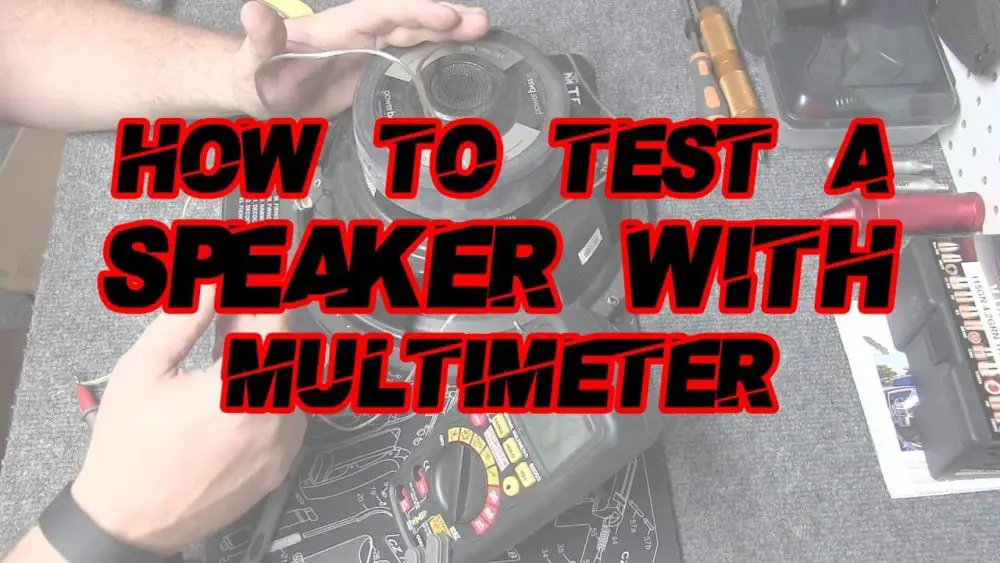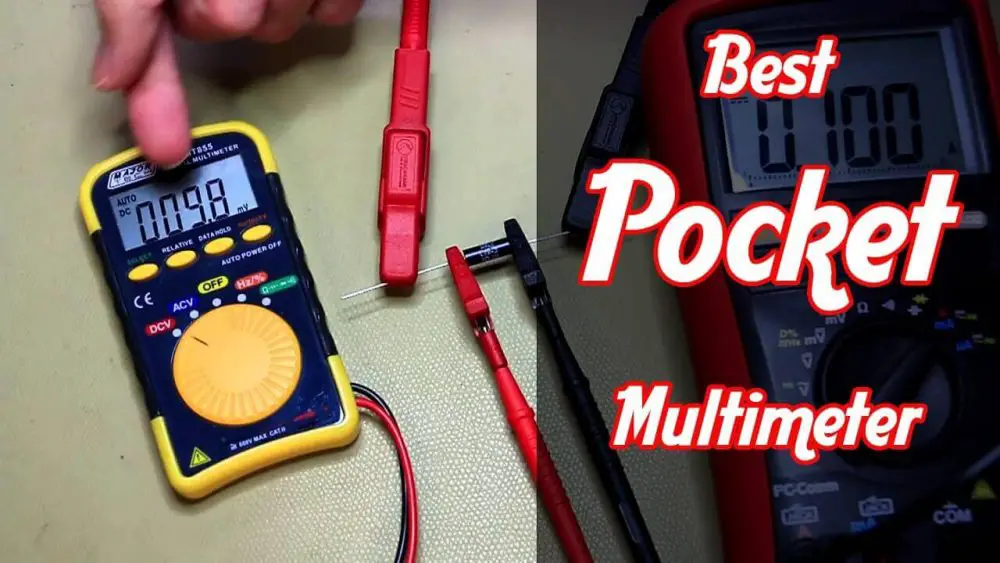How to test a Speaker with a Multimeter
To test the speaker, we will use a multimeter Fuke 87V and check its impedance. It is an example of a speaker’s resistance to an alternating current. The lower the impedance, the more current will be drawn from the amplifier to the speaker. If the impedance is too high for the amplifier, the volume and the dynamic range will suffer too low, and the amplifier could destroy itself trying to produce enough power. If you are confirming the broad range of your speakers, all you need is a multimeter. If you want to conduct a more accurate test, you will need some specialised tools.

Table of Contents
Speakers testing option 1:
- Check the label for a nominal impedance rating. Most speaker manufacturers list an impedance rating on the speaker label or the packaging. This “nominal” impedance rating (usually 4, 8, or 16 ohms) estimates the minimum impedance for typical audio ranges, and this usually occurs at a frequency between 250 and 400 Hz. The impedance is pretty close to this value within this range, and it rises as you increase the frequency. Below this range, the impedance changes rapidly, peaking at the resonant frequency of the speaker and its enclosure.
Some speaker labels display an actual, measured impedance for a specifically listed impedance.
These frequencies mean most bass tracks fall between 90 and 200 Hz, while “chest-thumping” sub-bass can be as low as 20 Hz. The midrange, including the majority of non-percussion instruments and voices, covers 250 Hz to 2kHz.
- Set a multimeter to measure resistance. A multimeter sends out a small D/C current to measure resistance. Since impedance is a quality of A/C circuits, this will not measure impedance directly. However, this approach will get you close enough for most home audio setups. (For example, you can easily distinguish between a 4-ohm and 8-ohm speaker this way.) Use the lowest range resistance setting, this is 200Ω for many multimeters, but a multimeter with a lower setting (20Ω) may give more accurate results.
If there is only one setting for a resistance, your multimeter is auto-ranging and will find the correct range automatically.
Too much D/C current can damage or destroy the voice coil of a speaker. However, the risk is low here since most multimeters only produce a small current.
- Remove the Speaker from its cabinet or open the back of the cabinet. If you are dealing with a loose speaker with no connections or speaker box, then there is nothing you need to do here.
- Cut off the power to the speaker. Any power running to the speaker will ruin your measurement and could burn your multimeter. Turn off the power. If the wires connected to the terminal are not soldered on, detach them.
Do not remove any wires connected directly to the speaker cone.
- Connect the multimeter leads to the speaker terminals. Look closely at the terminals and determine which is positive and which is negative. There is often a “+” and a “-” sign to identify them. Connect the multimeter’s red probe to the positive terminal and the black probe to the negative terminal.
- Estimate the impedance from the resistance. Typically, the resistance reading should be roughly 15% less than the nominal impedance on the label. For example, it is normal for an 8-ohm speaker to resist 6 or 7 ohms.
The majority of loudspeakers have a nominal impedance of 4, 8, or 16 ohms. So unless you get a strange result, it is safe to assume your speaker has one of these impedance values to pair it with an amplifier.
Speaker Testing Option 2:
- This option requires using a digital multimeter with a continuity setting.
- This setting is usually under the resistance setting.
- To test the continuity of the wires themselves and both ends of a single wire and test the continuity.
- Connect each end of the single wire to the positive and negative leads of the multimeter. Thus, if there is an unbroken circuit through the speaker, there will be a continuous tone output from the multimeter, and the meter will not read “OL” (open).
- Connect both ends of the speaker to the positive and negative leads of the multimeter. If there is an unbroken circuit through the speaker, there will be a continuous tone output from the multimeter, and the meter will not read “OL” (open).
Capacitor Testing:
- The capacitor test will require a digital multimeter with a capacitance testing option.
- Connect the positive lead of the multimeter to the positive lead of the capacitor, and vice versa for the negative. Thus, the capacitor’s functioning and the multimeter will give a reading similar to the ratings shown on the capacitor casing.
- NOTE: If the capacitor reading is -5% of its given base rating, the capacitor is considered faulty.
Possible Causes of Speaker Problems
Sound issues in your speakers
Grounding –
Do you observe loose or disconnected ground wires on your speaker? If yes, you can relocate the cables to a stable and secure location. You would know if there is a ground wire because there would be a whining and buzzing sound in the audio system.
Blown Speakers –
A blown speaker often causes a distorted sound. When this happens, there’s no chance of repairing the speaker. Your only solution is to replace the speaker. Take note: visible damage to the speaker is one of the signs of a blown speaker.
Amplifier Settings –
Sometimes, speaker problems come from amplifier settings. Check the settings of the amplifier for you to have secure speaker connections.
Loose or Disconnected Connections :
Speaker connectors and wires often become disconnected or loose. So, inspect the connections and wires of your speakers carefully. Then, check each area of the sound system to ensure there are no issues with the cables and connectors. (We’ll talk about how to test speaker ohms with a multimeter later.)
Testing the Speaker Ohms with Multimeter
A digital multimeter (DMM) is a handy device to measure the volts, resistance, and continuity of a circuit or electrical component. The multimeter is also an excellent device to use for basic testing or troubleshooting of your speakers.
Don’t worry if you’re a beginner at using a multimeter. Remember: you don’t need to be an expert to test speaker ohms utilising a multimeter. Here are straightforward steps you need to follow:
1. Turn off the speaker
Before working with electronics, don’t forget the safety rule – turn off the component. You can get hurt or damage the speaker if you don’t turn it off. Also, you face multiple problems if you don’t turn off the device.
2. Remove the Speaker Wires
Now, you are ready to remove the speaker wires. Before you do that, check the cables first before removing these from the box. (Take note: this is an essential step for the positive and negative wires of the speaker.) Next, press the two clips holding the wire, or you can twist the connectors counterclockwise.
Next, remove the speaker wires from the receiver. Remember: Don’t remove the wire while the speaker’s lock mechanism is engaged. Instead, you need to press the clips together by using an electric screwdriver or (if you like) remove the wires by twisting the lock.
3. Connect Speaker Wires
Here’s the step where you would create a circuit. You can do this by twisting two separate cables together. Hence, you have a perfect closed circuit for testing continuity.
Note: Don’t twist the wires together tightly. Why? You might experience separating the wires later, which leads to damage.
4. Setup the Multimeter
Turn on the digital multimeter and set the dial to the Ohms function. (People often use this option in testing resistance, and we’ll use this now to check the speaker ohms.) Make sure the test meter is in working before you test the speakers. Touch the red and black probes to one another.
Keep in mind that the multimeter should read zero ohms, which means the test meter has no defects. But if you see another reading, there’s an issue with your multimeter. So it would be best if you bought a new multimeter before proceeding to the next step.
5. Test the Wire
In this final step, you touch the test meter’s two probes to the speaker wires. Again, do this on two untwisted wires.
Frequently Asked Questions
Well, there might be a cut or break in certain parts of the wire. An excellent solution to prevent this is to replace the speaker wires.
Attach the multimeter probes to each terminal of the speaker where the wires are attached. For example, if the multimeter reads 1.0 ohms, the speaker is working if it displays a reading of infinite ohms, the speaker is blown.
Conclusion
It can be a burden trying to figure out what is wrong with your sound system, but it doesn’t need to be. You can quickly fix most issues with your speakers and wires. First, grab your multimeter and test your speaker wiring, as this tends to be a common problem. Then, if that doesn’t show anything, follow through with trying the other aspects of your system as well.
Related posts:
Test 3 Wire Crank Sensor with Multimeter



